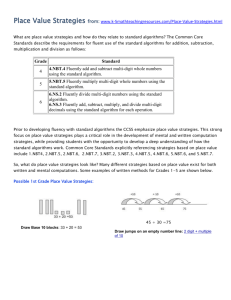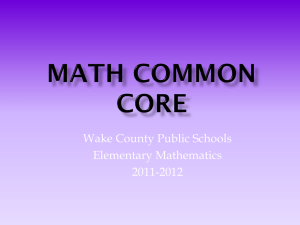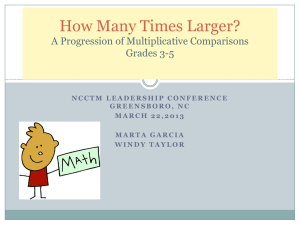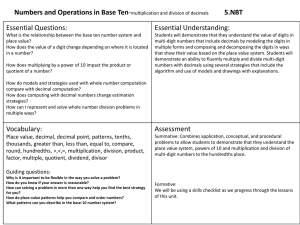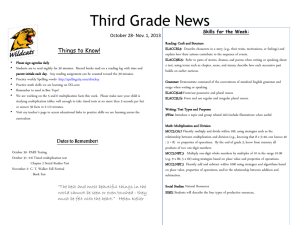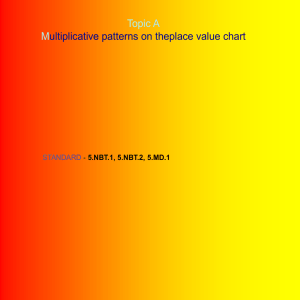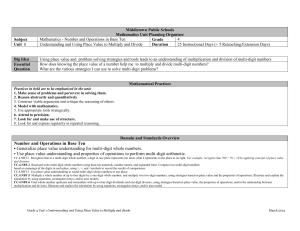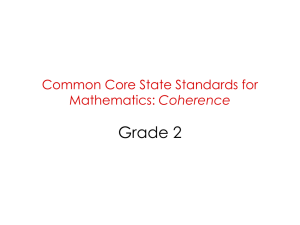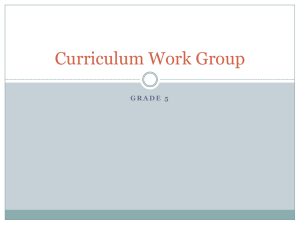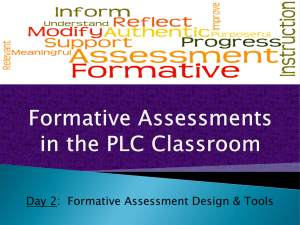grade 4
advertisement
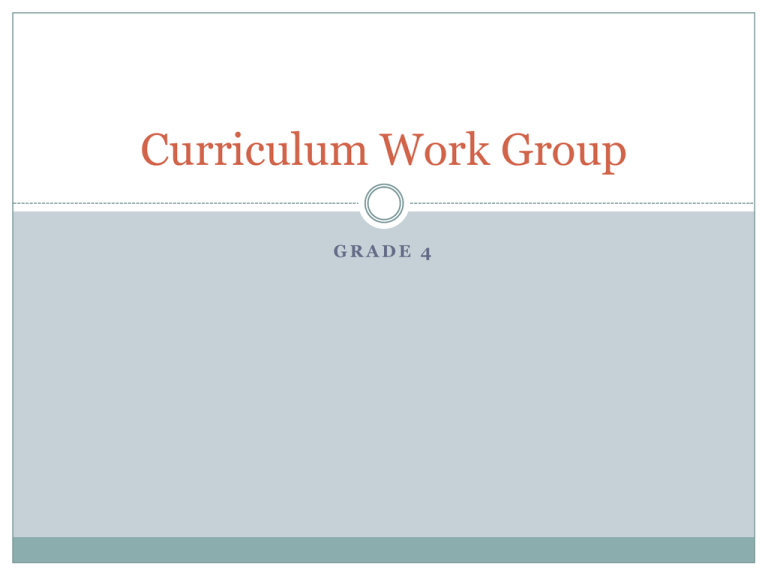
Curriculum Work Group GRADE 4 Agenda Present the pacing calendar Unit 1 Review unit plan document Resources for the unit Essential Resource List for Grade 4 Pacing Calendar Review the calendar and provide feedback. Time within units Order of units 5 minutes Grade 4 Pacing Calendar Unit Title Pacing Standards 1. Understanding and Using Place Value to Multiply and Divide 5 weeks 4.NBT.1 4.NBT.2 4.NBT.3 2. Factors and Multiples 2 weeks 4.OA.1 4.OA.4 4.OA.5 3 weeks 4.OA.2 4.OA.3 4.NBT.4 4. Comparing Fractions and Understanding Decimal Notation 4 weeks 4.NF.1 4.NF.2 4.NF.5 5. Building Understanding of Addition, Subtraction, and Multiplication of Fractions 6 weeks 4.NF.3 4.NF.4 4.MD.4 6. Solving Problems involving Measurement and Data 3 weeks 4.MD.1 4.MD.2 4.MD.3 7. Exploring Angles and Angle Measurement 2 weeks 4.MD.5 4.MD.6 4.MD.7 8. Understanding Properties of Two-Dimensional Figures 3 weeks 4.0A.5 4.G.1 3. Multi-Digit Whole Number Computation 4.NBT.5 4.NBT.6 4.NF.6 4.NF.7 4.G.2 4.G.3 Unit Plans Format is new but the content is relatively the same Follows the Understanding by Design Model Note each section of the document and its use for your planning purposes Unit 1 Understanding and Using Place Value to Multiply and Divide Essential Questions How does the position of a digit affect its value? How are place value patterns repeated in numbers? How can place value properties aid computation? What are efficient methods for finding products and quotients? What are strategies to make a reasonable estimate? Big Idea Place value is based on groups of ten. Flexible methods of computation involve grouping numbers in strategic ways. Proficiency with basic facts aids estimation and computation of larger and smaller numbers. Estimation is a way to get an approximate answer. 4.NBT.2 Standard 4. NBT.2. Read and write multi-digit whole numbers using base-ten numerals, number names, and expanded form. Compare two multi-digit numbers based on meanings of the digits in each place, using >, =, and < symbols to record the results of comparisons. * * Grade 4 expectations in this domain are limited to whole numbers less than or equal to 1,000,000. Explanation and Example 4.NBT.2. The expanded form of 275 is 200 + 70 + 5. Students use place value to compare numbers. For example, in comparing 34,570 and 34,192, a student might say, both numbers have the same value of 10,000s and the same value of 1000s; however, the value in the 100s place is different so that is where I would compare the two numbers. 4.NBT.1 Standard 4.NBT.1. Recognize that in a multi-digit whole number, a digit in one place represents ten times what it represents in the place to its right. For example, recognize that 700 ÷ 70 = 10 by applying concepts of place value and division. * Grade 4 expectations in this domain are limited to whole numbers less than or equal to 1,000,000. * Explanation and Example 4.NBT.1. Students should be familiar with and use place value as they work with numbers. Some activities that will help students develop understanding of this standard are: • Investigate the product of 10 and any number, then justify why the number now has a 0 at the end. (7 x 10 = 70 because 70 represents 7 tens and no ones, 10 x 35 = 350 because the 3 in 350 represents 3 hundreds, which is 10 times as much as 3 tens, and the 5 represents 5 tens, which is 10 times as much as 5 ones.) While students can easily see the pattern of adding a 0 at the end of a number when multiplying by 10, they need to be able to justify why this works. • Investigate the pattern, 6, 60, 600, 6,000, 60,000, 600,000 by dividing each number by the previous number. 4.NBT.3 Standard Explanation and Example 4.NBT.3. Use place value 4.NBT.3. When students are asked to round large numbers, they first need to identify which digit is in the appropriate place. understanding to round multi-digit whole numbers to any place. 2 2 Grade 4 expectations in this domain are limited to whole numbers less than or equal to 1,000,000. Example: Round 76,398 to the nearest 1000. • Step 1: Since I need to round to the nearest 1000, then the answer is either 76,000 or 77,000. • Step 2: I know that the halfway point between these two numbers is 76,500. • Step 3: I see that 76,398 is between 76,000 and 76,500. • Step 4: Therefore, the rounded number would be 76,000. 4.NBT.5 Standard 4.NBT.5. Multiply a whole number of up to four digits by a one-digit whole number, and multiply two two-digit numbers, using strategies based on place value and the properties of operations. Illustrate and explain the calculation by using equations, rectangular arrays, and/or area models. * Grade 4 expectations in this domain are limited to whole numbers less than or equal to 1,000,000. * Explanation and Example 4.NBT.5. Students who develop flexibility in breaking numbers apart have a better understanding of the importance of place value and the distributive property in multi-digit multiplication. Students use base ten blocks, area models, partitioning, compensation strategies, etc. when multiplying whole numbers and use words and diagrams to explain their thinking. They use the terms factor and product when communicating their reasoning. Multiple strategies enable students to develop fluency with multiplication and transfer that understanding to division. Use of the standard algorithm for multiplication is an expectation in the 5th grade. Students may use digital tools to express their ideas. Use of place value and the distributive property are applied in the scaffolded examples that follow. 4.NBT.5 continued • To illustrate 154 x 6 students use base 10 blocks or use drawings to show 154 six times. Seeing 154 six times will lead them to understand the distributive property, 154 X 6 = (100 + 50 + 4) x 6 = (100 x 6) + (50 X 6) + (4 X 6) = 600 + 300 + 24 = 924. • The area model shows the partial products. 14 x 16 = 224 Using the area model, students first verbalize their understanding: • 10 x 10 is 100 • 4 x 10 is 40 • 10 x 6 is 60, and • 4 x 6 is 24. They used different strategies to record this type of thinking. 4.NBT.5 continued Students explain these strategies with base 10 blocks, drawings, or numbers. 25 × 24 400 (20 × 20) 100 (20 × 5) 80 (4 × 20) 20 (4 × 5) 600 25 × 24 500 (20 × 25) 100 (4 × 25) 600 Matrix model: This model should be introduced after students have facility with the previous strategies. 20 5 20 400 100 500 4 80 20 480 + 120 100 600 4.NBT.6 Standard Explanation and Example 4.NBT.6. Find whole-number 4.NBT.6 In fourth grade, students build on their third grade work with division within 100. Students need opportunities to develop their understandings by using problems in and out of context. quotients and remainders with up to four-digit dividends and one-digit divisors, using strategies based on place value, the properties of operations, and/or the relationship between multiplication and division. Illustrate and explain the calculation by using equations, rectangular arrays, and/or area models. 2 Grade 4 expectations in this domain are limited to whole numbers less than or equal to 1,000,000. 2 Examples follow… 4.NBT.6 continued Examples: A 4th grade teacher bought 4 new pencil boxes. She has 260 pencils. She wants to put the pencils in the boxes so that each box has the same number of pencils. How many pencils will there be in each box? • Using Base 10 Blocks: Students build 260 with base 10 blocks and distribute them into 4 equal groups. Some students may need to trade the 2 hundreds for tens but others may easily recognize that 200 divided by 4 is 50. • Using Place Value: 260 ÷ 4 = (200 ÷ 4) + (60 ÷ 4) • Using Multiplication: 4 x 50 = 200, 4 x 10 = 40, 4 x 5 = 20; 50 + 10 + 5 = 65; so 260 ÷ 4 = 65 4.NBT.6 continued Using an Open Array or Area Model After developing an understanding of using arrays to divide, students begin to use a more abstract model for division. This model connects to a recording process that will be formalized in the 5th grade. Example 1: 150 ÷ 6 Students make a rectangle and write 6 on one of its sides. They express their understanding that they need to think of the rectangle as representing total of 150. 1. Students think, 6 times what number is close to 150? They recognize that 6 × 10 is 60, so they record 10 as a factor and partition the rectangle into 2 rectangles and label the area aligned to the factor of 10 with 60. They express that they have only used 60 of the 150, so they have 90 left. 2. Recognizing that there is another 60 in what is left, they repeat the process above. They express that they have used 120 of the 150, so they have 30 left. 3. Knowing that 6 × 5 is 30, they write 30 in the bottom area of the rectangle and record 5 as a factor. 4. Students express their calculation in various ways: a. b. 150 - 60 (6 × 10) 90 - 60 (6 × 10) 30 - 30 (6 × 5) 0 150 ÷ 6 = 10 + 10 + 5 = 25 150 ÷ 6 = (60 ÷ 6) + (60 ÷ 6) + (30 ÷ 6) Example 2: 1917 ÷ 9 A student’s description of his or her thinking may be: I need to find out how many 9s are in 1917. I know that 200 × 9 is 1800. So if I use 1800 of the 1917, I have 117 left. I know that 9 × 10 is 90. So if I have 10 more 9s, I will have 27 left. I can make 3 more 9s. I have 200 nines, 10 nines and 3 nines. So I made 213 nines. 1917 ÷ 9 = 213. Unit 1 Work Groups EDM/Math Trailblazers alignment Using the correlation documents and your experience, identify which lessons/activities align to this unit Additional resources alignment Using the additional resources, identify which lessons/activities align to this unit Internet resources Using the suggested resources and others you identify, find lessons/activities that align to this unit CMT Alignment Using the CMT framework and handbook, identify the strands that can be embedded in this unit Lessons Using the lesson template, record any lessons you have used or would like to use that align to this unit Interdisciplinary activities/lessons Specialists – how can you address the standards in this unit in the work that you do? Review of Resources/Materials to Purchase Review instructional materials Thoughts Additions Take the Classroom Resources survey on P21 Make sure to choose Grade Four!
